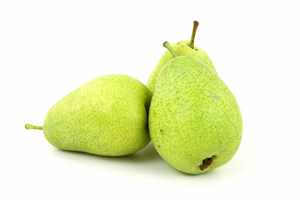Pear (Pyrus)
Main Facts about Pear

Using Pear
Pears are rich in important antioxidants, flavonoids and dietary fiber. Fiber contains no calories, and is a necessary element of a healthy diet as it helps sustain blood sugar levels and works as a mild laxative. In addition, they rarely cause allergies. The fiber in pears is beneficial for colon health. The high content of pectin in pears helps to lower cholesterol levels. The pectin is also diuretic. You can get quick and natural source of energy from pear juice, due largely to its high amounts of fructose and glucose. A glass of pear juice is excellent in relieving fever. Pear juice helps building up immune system. Drink pear juice when you feel a cold coming. It also has an anti-inflammatory effect and helps relieve sufferers of much pain in various inflammatory conditions. Pears contain high level of boron. Boron helps the body to retain calcium, thus prevents or decelerates osteoporosis. of fiber, a crucial nutrient for your skin. High fiber used for constipationPear is a remedy for: Constipation
Caution!
Pears are among the least allergenic of all fruits. Eating a lot of pears may increase gas, bloating, pain and diarrhea in people suffering from irritable bowel disorders.Cooking with Pear
Pears are consumed fresh, canned, dried, and juiced. The juice can also be used in jellies and jams. Fermented pear juice is called perry or pear cider. Since their skin provides about half of the pear's total dietary fiber as well as its antioxidant and anti-inflammatory phytonutrients, it is best to not peel the fruit but eat the entire pear.How to grow Pear
The pear is normally propagated by grafting a selected variety onto a rootstock, which may be of a pear variety or quince. Can handle cold quite well. They grow in full sun in sandy, loamy soil. Plan to plant at least two varieties of pear trees because they need to be cross-pollinated to produce fruit. Make sure the varieties are compatible with each other. Water well and continue to water regularly until the roots are well established. The first pruning should occur as soon as your tree is planted.| Peach |
Peppermint
|